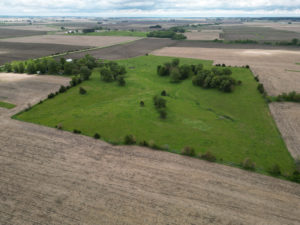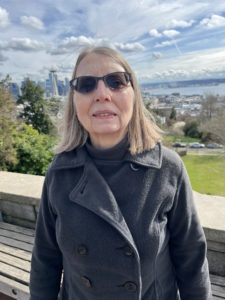Mapping a Path to Conservation
Partnering with Pheasants Forever and her farm manager is helping Diane Horn shift the direction of her family farmland
Diane Horn lives in Seattle, Washington, half a continent and a world away from Iowa City, Iowa, where she was born. At age 4, her life became a steady unfolding of new chapters in new places: Cedar Falls, Iowa; Austin, Texas; college in California; graduate school in Indiana; and her eventual move to Seattle, where she worked as a cancer researcher.
Later, she moved again – not from a location, but to a new career as a radio talk show host focused on environmental, social and economic issues. But no matter how many places she has lived, Iowa has remained a touchstone in her life. In 2006, Diane inherited her mother’s farm, an enduring link connecting her back to the land and legacy of her home state.
The roughly 370-acre corn and soybean farm passed through four generations before her. But it also represents a legacy for its tenants: The same family has worked the land for 50 years. “The tenants have been a father-son duo,” Diane says. “The father rented it from my family, and now his son is the farm operator. It means a lot to have that long of a relationship in tenant farming.”
With Diane living so far away, she relies on a local farm manager to help oversee the farmland and assist the tenant farm operator to make critical production and land management decisions. Jake Thomsen of Growthland, who has an agronomy degree and a down-to-earth demeanor, has been serving in that role since 2022.
“About a year ago, Diane reached out to me wondering what kind of conservation practices could be put into place on the farm,” Jake says. “I agreed that it was a great idea.”
“I’ve always wanted to do more for the land,” Diane says. “But I didn’t know where to start.”
A Spark and a Connection
Diane’s journey toward conservation on the farm began not long after Jake took over managing the farm.
In the spring of 2024, Diane learned about Pheasants Forever and their work with precision conservation through PFI’s quarterly magazine and a follow-up conversation with Grace Yi, PFI’s habitat viability manager. Precision conservation is an analytical process that uses spatial technology and data analysis to pinpoint underperforming areas of a farm that may be better served by alternative management, such as perennial plantings.
The approach intrigued her, and she reached out to Jake to express her interest. Diane and Jake both agreed that a precision conservation analysis would be a good first step to make Diane’s farm more environmentally friendly. Through PFI, they were put in touch with Stephanie Nelson, a precision agriculture and conservation specialist with Pheasants Forever.
Stephanie helps landowners and farmers access and analyze maps and data about their farms to find opportunities for habitat that fit into the larger context of the farm operation. She worked with both Diane and Jake to explore the options for integrating precision conservation on Diane’s farm. Stephanie and Jake walked the land together to discuss possibilities, and Jake communicated with Diane’s tenant.
Stephanie started by creating the analysis map. “Mapping gives us views of the land from different lenses,” she says. “We can look at soils, slope and vegetation patterns over time. When yield data is not available, we can turn to NDVI [normalized difference vegetation index], a satellite-based dataset that is correlated with yield, showing plant health and density.”
NDVI revealed puzzling gaps in the cropland of Diane’s farm. On Stephanie’s maps, they appeared simply as low-performing areas. But on the ground, they told a more detailed story.
“During the site visit, we walked out to one of these gaps and realized it was grass around an area of exposed bedrock,” Stephanie says. “This helped me understand some of the NDVI patterns I observed and led me to make some suggestions about possible programs to expand those grassy areas.”

An aerial view of precision conservation in action on Diane’s family farm in May 2025. Low yield acres were retired from production and restored to habitat. Drone photo courtesy of Jake Thomsen.
Instead of continuing to farm next to the bedrock areas, Stephanie suggested expanding the grassy areas around it. This would create buffers and help protect farm equipment. It would also shift the focus back to more productive areas of the farm.
The analysis maps also revealed another opportunity along the stream running in the southern part of the field. The NDVI showed crop impacts from the wet soils in that floodplain. Instead of losing money on crop inputs in that area, seeding it to perennial prairie would help filter surface runoff and provide a habitat corridor along the stream.

Second ariel view of precision conservation in action on Diane’s family farm in May 2025. Low yield acres were retired from production and restored to habitat. Drone photo courtesy of Jake Thomsen.
“Diane is really motivated to improve the habitat, but she’s also very thoughtful about how it impacts the farm operation,” Stephanie says. “Since she and the tenant are in a 50-50 crop share, she’s invested in the farm’s success, not just ecologically but economically, too.”
Restoring a Quiet Creek
Farm Service Agency’s Conservation Reserve Program. She will also receive a precision conservation incentive through Pheasants Forever. The latter program, available in Iowa and Minnesota, helps farmers identify and transition unprofitable farmland into wildlife habitat. Participants receive a one-time incentive payment, while the Conservation Reserve Program provides multiyear financial support.
But Diane is adamant that even without the funds provided through these programs, conservation would be going forward on the farm. She is concerned about the water quality flowing into the Mississippi River that drains to the Gulf Coast.
“I’ve had a long-standing interest in environmental protection,” she says. “For a long time, I had wanted to do things on the farm that would make it more environmentally friendly.”
As the project gets started next year, Jake and Diane are both eager to see how the new grassland habitat, as well as the shift to farming the more productive areas, will benefit the farm. For Jake, being part of the project has given him the chance to manage a farm that’s amid a conservation transition. It has also let him gain skills serving as a liaison between a landowner and tenant during that process.
“What I learned here, I’ll carry to every other farm I work with,” Jake says.
Diane is hopeful the changes will lead to better water quality and a more resilient farm. “I hope that putting in this buffer along the stream will increase the quality of the water coming from the land and increase productivity, because these are areas of the farm where it actually costs more to farm than not.”
She also hopes to soon see more wildlife calling the land home – deer, pheasants, grassland birds and passing wildlife who will find a quiet Iowa creek bordered by native grasses to sustain them. And though Diane’s home is far away, the choices she’s making for her farmland are part of the legacy she’s leaving here for Iowa – and beyond.

